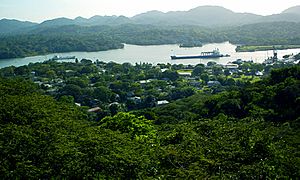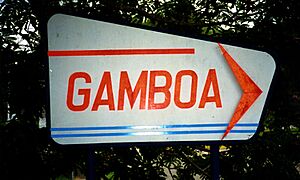Gamboa, Panama facts for kids
Quick facts for kids
Gamboa
|
|
|---|---|
 |
Gamboa is a small town in the corregimiento of Cristóbal in the Colón Province, Panama. It is very close to the famous Panama Canal and the Chagres River. Gamboa was one of the towns built to house people who worked for the Panama Canal. The name Gamboa comes from a type of tree, similar to a quince tree.
Today, Gamboa is known as a great place for ecotourism, where people can enjoy nature.
Contents
Where is Gamboa?
Gamboa is located on a sharp bend of the Chagres River. This river flows into Lake Gatun. Just south of Gamboa, Lake Gatun and the Chagres River meet the Culebra Cut (also called Gaillard Cut). This is where the Canal cuts through the Continental Divide.
Even though Gamboa is closer to the Pacific Ocean side of Panama, its rivers flow towards the Atlantic Ocean. For many years, the only way to drive into Gamboa was over a single-lane iron and wood bridge. This old bridge is still there today. However, in October 2018, a new two-lane bridge was built nearby, making it easier to get to Gamboa.
A Look Back: Gamboa's History
Gamboa was built near an older village called Santa Cruz. Further up the Chagres River was the town of Las Cruces. In the 1800s, travelers and goods would get off river boats there. They would then take the Las Cruces trail by mule. After the Panama Railroad was finished in 1855, it ran near Gamboa, but no towns were listed in its current spot.
Building the Town
The town of Gamboa we know today was built in 1911. This was during the construction of the Panama Canal. At first, it was home to about 700 workers and their families. These workers were mainly from the Caribbean and other non-U.S. countries. They had to move from areas that were flooded by Lake Gatun as the Canal was built. No Americans lived in Gamboa at this time.
By 1914, when the Canal was finished, Gamboa's population dropped to only 173 people. The town had a police station and a few houses. Some of these houses were moved from other towns that were being covered by water. There were also old railroad cars used as homes for some workers. The first store, called a commissary, also operated out of three railroad cars.
The Dredging Division Moves In
After many years of discussions, the Panama Canal Company decided to move its Dredging Division to Gamboa. This division was responsible for keeping the Canal clear. The move happened in 1936. Before the move, in 1933, Gamboa had only 251 people, with just 10 Americans.
The first families from the Dredging Division started moving to Gamboa in September 1936. Within a year, the town's population grew a lot, to 1,419 people. By 1942, Gamboa reached its highest population, with 3,853 residents.
Community Spirit and Growth
The new residents of Gamboa built their own community center. They used their own hands and money! At first, it was a place for soldiers stationed nearby to relax. Later, it became the main office for the town's Civic Council. The people of Gamboa also built the Gamboa Golf and Country Club. It was located on Gamboa Ridge, with views of the Chagres River.
The men worked hard building, while the women brought food and organized barbecues. The club officially opened on January 1, 1939. It eventually had a 9-hole golf course.
Life in the Canal Zone
Like most towns in the Panama Canal Zone, Gamboa had its own store (commissary), post office, school, and churches. It also had a railroad station, fire station, and gas station. For much of its history, non-U.S. residents lived in a separate part of town called Santa Cruz. This included 50 families who moved from La Boca in 1954.
Not everyone in Gamboa worked for the Dredging Division. Gamboa was a bit far from other Canal Zone towns. Because housing was given based on how long you had worked there, many new employees first lived in Gamboa. Later, they could move to other towns. U.S. military families also lived in Gamboa during the 1940s due to housing shortages on military bases. U.S. personnel continued to live in Gamboa until 1999. This was when all U.S. troops left Panama.
Changes Over Time
Over the years, the Panama Canal Company began to transfer its operations to Panama. This happened after the 1977 Panama Canal Treaties. Some services in Gamboa started to close down. The store and movie theater were boarded up in the 1980s. The Panama Railroad also stopped running in the late 1980s. This made Gamboa feel even more cut off from other areas.
Gamboa Elementary School
Gamboa's elementary school was built in 1937. It had three classrooms, a library, and a principal's office upstairs. A kindergarten classroom was located downstairs. In 1979, the school was transferred to the Department of Defense Dependents Schools (DoDDS). This happened after the Panama Canal Zone government was ended.
That school year, 115 students were enrolled. Three U.S. teachers taught combined classes. For example, first and second graders shared one room. A physical education teacher also taught in the school's gym. By the 1987–1988 school year, enrollment dropped to 53 students. In June 1988, the school closed. All students were then bused to Balboa Elementary. After a military operation in December 1989, the school building was used by U.S. Military Police.
The golf course in Gamboa became a Boy Scout camp for several years. However, it was not used much in the last years before the Canal was fully returned to Panama.
Gamboa Today: Nature and Research
The town of Gamboa is still home to people today. However, it is quieter than it used to be. Many houses are empty, and some public buildings are not fully used. It is still the main headquarters for the Dredging Division of the Panama Canal Authority.
The Dredging Division's docks are used by small ferries. These ferries take people to the Smithsonian Tropical Research Institute (STRI) on Barro Colorado Island. This island is a famous place for scientific research.
Gamboa is surrounded by amazing wildlife. You can find caymans, crocodiles, iguanas, and hundreds of bird species here. Because of its location, Gamboa is next to large areas of untouched rainforest. A path called "Pipeline Road" is known as one of the best places for birding in Panama. It is a top spot for bird watching in Central America. Many amateur birdwatchers join scientists for yearly bird counts near Gamboa. These counts are organized by the Audubon Society of Panama.
The old Spanish colonial Las Cruces Trail also passes near Gamboa. This trail was used to carry precious metals and supplies between the Atlantic and Pacific oceans. Parts of it are now underwater.
See also
 In Spanish: Gamboa (Panamá) para niños
In Spanish: Gamboa (Panamá) para niños




